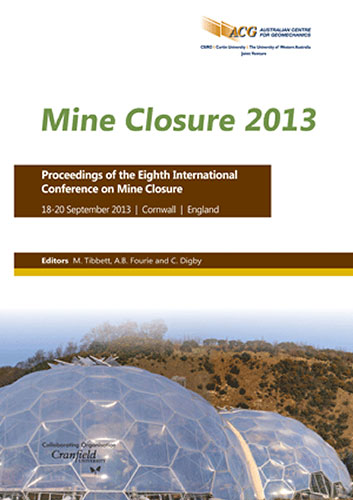Reclaimed landscapes — incorporating cultural values

|
Authors: Jones, CE; MacLean, MIA Paper is not available for download Contact Us |
DOI https://doi.org/10.36487/ACG_rep/1352_37_Jones
Cite As:
Jones, CE & MacLean, MIA 2013, 'Reclaimed landscapes — incorporating cultural values', in M Tibbett, AB Fourie & C Digby (eds), Mine Closure 2013: Proceedings of the Eighth International Seminar on Mine Closure, Australian Centre for Geomechanics, Cornwall, pp. 441-446, https://doi.org/10.36487/ACG_rep/1352_37_Jones
Abstract:
Reclaimed landscapes at open pit mines are often quite different than the landscape prior to mine development. Planned land use at mine closure is typically an important component of mine reclamation regulations, but how these land uses are distributed and their proportion on the reclaimed landscape may have changed from the previous condition. What must be critically assessed is how the proposed land uses of the reclaimed landscape will provide the resources required to meet the end user’s values of the land. This requires both a thorough assessment of the cultural values of the people who will use the landscape (and may have used the landscape prior to mining) and an understanding of those ecological components of the landscape that provide the services to support these values. Using the example of Fort McKay First Nation’s traditional lands that are situated in the centre of Canada’s oil sands mining developments, this paper investigates the linkages between Fort McKay First Nation’s values that are connected to cultural activities and the components of the reclaimed landscapes that will be necessary to provide the opportunity to conduct these activities. We examine, from a landscape ecology perspective, how mine reclamation plans can incorporate all of the necessary landscape elements and appropriate spatial heterogeneity that are related to the ecological processes required to achieve the land use objectives.
References:
Alberta Environment (2009) Guidelines for Reclamation to Forest Vegetation in the Athabasca Oil Sands Region, December 2009, Edmonton, Alberta.
Buffalo, K., Jones, C.E., Errington, J.C. and MacLean, M.I.A. (2011) Fort McKay First Nation’s involvement in reclamation of Alberta’s oil sands development, in Proceedings Sixth International Conference on Mine Closure (Mine Closure 2011), A.B. Fourie, M. Tibbett and A. Beersing (eds), 19‒21 September 2011, Lake Louise, Canada, Australian Centre for Geomechanics, Perth, Vol. 1, pp. 255–261.
Fitzpatrick, C. (2003) Creating wetlands in oil sands reclamation, Workshop proceedings, Cumulative Environmental Management Association, Fort McMurray, Alb.
Fort McKay Industry Relations Corporation (2010) Cultural heritage assessment baseline Fort McKay Specific assessment (Supplemental information for the Shell Canada Limited Jackpine mine expansion and Pierre River mine project application), Canadian Environmental Assessment Agency, Ottawa, pp. 18–29.
Frid, L. and Daniel, C. (2012) Development of a state-and-transition simulation model in support of reclamation planning, Cumulative Environmental Management Association, Fort McMurray, Alberta, pp. 30–31.
Garibaldi, A. (2009) Moving from model to application: cultural keystone species and reclamation in Fort McKay, Alberta Journal of Ethnobiology 29 Issue, pp. 323–338.
Harris, M.L. (2007) Guideline for wetland establishment on reclaimed oil sands leases (revised 2007 edition), Alberta Environment Report No. ESD/LM00-1, Publication No. T/517, Edmonton, Alberta.
Hawkes, V.L. (2011) Early successional wildlife monitoring on reclamation plots in the Athabasca oil sands region, in Proceedings Sixth International Conference on Mine Closure (Mine Closure 2011), A.B. Fourie, M. Tibbett and A. Beersing (eds), 19‒21 September 2011, Lake Louise, Canada, Australian Centre for Geomechanics, Perth, Vol. 2, pp. 229–237.
Rooney, R.C. and S.E. Bayley (2011) Development and testing of an index of biological integrity based on submersed and floating vegetation and its application to assess reclamation wetlands in Alberta's oil sands area, Canada, Environmental Monitoring and Assessment.
© Copyright 2025, Australian Centre for Geomechanics (ACG), The University of Western Australia. All rights reserved.
View copyright/legal information
Please direct any queries or error reports to repository-acg@uwa.edu.au
View copyright/legal information
Please direct any queries or error reports to repository-acg@uwa.edu.au